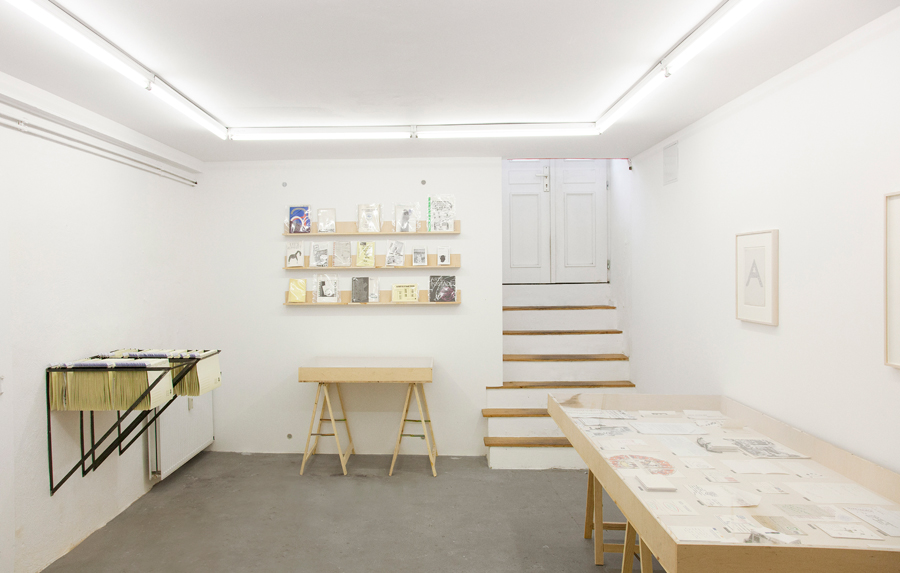Ruth Wolf-Rehfeldt and Robert Rehfeldt
ChertLüdde, Berlin, Germany
ChertLüdde, Berlin, Germany

There is a tradition that places the archive amidst a set of notions indebted to Jacques Derrida’s meditations on ‘fever’, ‘spectres’ and ‘hauntings’. The archive, in this respect, represents an exploration of the dark side of history; a navigation of, exploration of, hidden pasts. ‘A: The Mail Art Archive of Ruth Wolf-Rehfeldt and Robert Rehfeldt’ at ChertLüdde, Berlin, takes a wholly different tact, luminously associating the archive with fluid concepts such as networks, friendships and anonymity.
Ruth Wolf-Rehfeldt was born in East Germany in 1932 and relocated to Berlin in 1950, where she met her husband, the experimental artist Robert Rehfeldt. In 1970, she began her ‘Typewritings’ series, which she continued until the Berlin Wall came down in 1989. Her recently rediscovered catalogue comprises almost 1,000 of these works: geometric visual poems, typewritten on A4 paper so as to be distributed by mail, which range from abstract typographic repetitions to emotional linguistic experiments to renderings of architectural shapes, objects and human silhouettes.

What is most striking about this exhibition is its modest display. No ‘atlas’, no ‘constellation’, no ‘artist’s museum’, just a few vitrines, some framed works and a series of alphabetized files into which the viewer, having donned white gloves, can dig. The exhibition includes mail art that was sent to the couple by an international community of artists, collectives and collective publications whose names begin with the letter A, but it revolves around two central works. The first, by Robert, is a newsletter that was sent in 1977 as part of the ‘Artworker Actual News’ series; the second, a seminal work by Ruth, A wie Arsen (1972), a concrete poem in the form of a wide capital A. This exhibition, and the comprehensive catalogue that accompanies it, introduces a major publishing project that will see a total of 26 books produced under the umbrella of The Mail Art Archive of Ruth Wolf-Rehfeldt and Robert Rehfeldt, each of which will be organized around a different letter of the alphabet. This curatorial logic reveals a tension between the couple’s painstaking coordination of their artist network and the informality of the archival process itself – the pair having chronicled the myriad submissions in a subjective, personal way. In this sense, the choice of placing these two works at the centre of the show makes sense: this archive is founded in the rational attempts of two individuals to establish themselves as part of a global, artistic map, but it is a map that is brought into existence by notions of shared authorship, omnipresence and cross-contamination. Accordingly, A wie Arsen translates as ‘A for Arsenic’.

The choice of the letter ‘A’ as an organizing principle for this exhibition might be interpreted as a statement. ‘A’ is for the artists’ archive, one that differs from that of the institution in its aims, internal organization and the way it is circulated. ‘A’ is also for anonymity, and the way that the display includes anonymous productions – works that were not assigned, but were meant to exist as floating objects. ‘A’ could also refer to the Swiss artist John Armleder, whose collective Ecart employed a similar method in the 1970s and ’80s in order to confuse the frontiers of artistic production and circulation. Armleder is represented in the archive by postcards, invitations and poems, one of which, from 1975, provides poetic support for this exhibition’s proposition that the archive can exists as a fluid, cohabitated space: ‘I have often seen my works, but signed with other names’.
Main image: "A –The Mail Art Archive of Ruth Wolf-Rehfeldt and Robert Rehfeldt”, exhibition view at ChertLüdde, Berlin. Courtesy: the Ruth Wolf-Rehfeldt and Robert Rehfeldt Mail Art Archive and ChertLüdde, Berlin
























